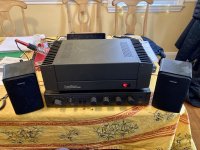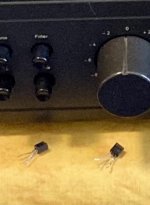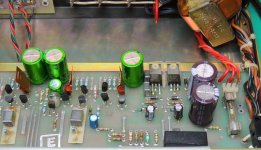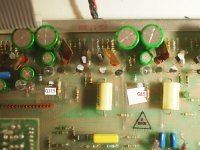Well, okay, but I just don't get how using a normal contact cleaner, most of which evaporate in seconds or minutes, would have long-term effects on caps and transistors. Some have a lubricant in them that sticks around, and is helpful for keeping pots from being scratchy. Maybe they would do some harm. I wonder what was used on the Neve console.
This sort of information should go into the a thread on contact cleaners (there are a few on DYI Audio). Your horror stories would add a lot to them, as most if not all of the posts I looked at were as casual as mine are.
Regarding high-reliability technicians, I visit the tekscopes forum a fair amount to glean knowledge. Most of the participants worked for Tektronix and are trained engineers. I never heard anyone there shy away from using contact cleaners, although there are some delicate switches that have to be cleaned carefully to avoid mechanical damage.
We are way-off topic here, so this is it for me. Thanks for your input, I appreciate it, even if I don't totally agree with it I always learn something.
This sort of information should go into the a thread on contact cleaners (there are a few on DYI Audio). Your horror stories would add a lot to them, as most if not all of the posts I looked at were as casual as mine are.
Regarding high-reliability technicians, I visit the tekscopes forum a fair amount to glean knowledge. Most of the participants worked for Tektronix and are trained engineers. I never heard anyone there shy away from using contact cleaners, although there are some delicate switches that have to be cleaned carefully to avoid mechanical damage.
We are way-off topic here, so this is it for me. Thanks for your input, I appreciate it, even if I don't totally agree with it I always learn something.
Alas I have removed the cover, inspected closely and see nothing wrong. Looks like the day I assembled it in 1980. Off to the experienced electronics guy it goes. I have enough stuff to fix in the new house as it is.
If you can, please let us know what the problem was.
Well, okay, but I just don't get how using a normal contact cleaner, most of which evaporate in seconds or minutes, would have long-term effects on caps and transistors. Some have a lubricant in them that sticks around, and is helpful for keeping pots from being scratchy. Maybe they would do some harm. I wonder what was used on the Neve console.
This sort of information should go into the a thread on contact cleaners (there are a few on DYI Audio). Your horror stories would add a lot to them, as most if not all of the posts I looked at were as casual as mine are.
Regarding high-reliability technicians, I visit the tekscopes forum a fair amount to glean knowledge. Most of the participants worked for Tektronix and are trained engineers. I never heard anyone there shy away from using contact cleaners, although there are some delicate switches that have to be cleaned carefully to avoid mechanical damage.
We are way-off topic here, so this is it for me. Thanks for your input, I appreciate it, even if I don't totally agree with it I always learn something.
I have to clean the residue of the contact cleaner from all over the board after spraying it and waiting the time stated on the can. it's an oily residue. I don't want the residue to create a short by it creating an electrical path to where it's not needed. So, I now use a q-tip to apply and clean switches and pins. Alcohol and a toothbrush to clean and after soldering.
I also have a channel out on my dh110. so, I'll be trying out some of the recommendations in this thread. caps and jfets need replacing. it's a first dh-110 generation version; certainly it needs it. so far, only a j-fet is testing weak.
R- channel was low volume/out of balance with L-channel. took out R-channel j-fet. it tested like a new one last night. today it tests like an npn transistor. did not install j-fet back. R-channel is now balanced with L-channel. don't understand why the j-fet would go out after replacing it new and just a few months of use. had volume way high with amp volume low. don't recall if j-fet purchased on the bay or digikey.
Hi Raycarr00,
It is certainly possible that the out of spec resistors could do this if far enough out. The J-Fet will act as a variable resistor and the circuit is not be designed to be linear, so high distortion may also be present.
It is normal for J-Fet to test similar to a BJT using a diode test. I would normally quickly test for Idss and V-pinch (pinch-off voltage) as a quick test. You can find details on testing like that on Nelson Pass' web site and in some of his threads here.
So, how did things turn out?
-Chris
It is certainly possible that the out of spec resistors could do this if far enough out. The J-Fet will act as a variable resistor and the circuit is not be designed to be linear, so high distortion may also be present.
It is normal for J-Fet to test similar to a BJT using a diode test. I would normally quickly test for Idss and V-pinch (pinch-off voltage) as a quick test. You can find details on testing like that on Nelson Pass' web site and in some of his threads here.
So, how did things turn out?
-Chris
got tired of replacing the j-fets. they would test the same, using a chinese test everything tester, in comparison to new j-fets. resistors in the muting circuit were mostly out of spec- with 10k testing 7k, etc. resistors in this section have to be tested out of the circuit or the dmm will not read correctly- because of the zener diode. replacing the lm 393 with one from the bay caused the muting circuit to act up- noise and suppressed volume. resistors related to the rca input/ output board were slightly off.
Hi Raycarr00,
That's a sign they aren't the issue as long as you are buying "real" production parts.got tired of replacing the j-fets.
You mostly have to lift one leg to get a true reading. Back in the tube amp days you could often get away with just measuring the part in circuit, but not with solid state. Tube guys learned bad habits back then and I was one of them. Had to get bit a few times to smarten up.resistors in the muting circuit were mostly out of spec- with 10k testing 7k, etc.
What can I say? Many have been warning about questionable parts from Ebay and other sources for many years - and for good reason. Substitute the op amp with a current production part from a proper, authorized distributor. Its the only way to move forward.replacing the lm 393 with one from the bay caused the muting circuit to act up
Another reason to be grateful for this site: this thread popped up today and I repaired my DH-110 with the simple removal of two JFETs! Amazing!
I had tried deoxit first a while ago on its own and decided I didn’t want to go through a whole recap and parts replacement… Low and behold I could just remove two fets and voi la!
The preamp is a bit noisy compared to others I have, but it now works fine!
Time to set up another room with a system with which to cycle my various pandemic projects.
Don’t know how I missed this thread before…
Cheers!
I had tried deoxit first a while ago on its own and decided I didn’t want to go through a whole recap and parts replacement… Low and behold I could just remove two fets and voi la!
The preamp is a bit noisy compared to others I have, but it now works fine!
Time to set up another room with a system with which to cycle my various pandemic projects.
Don’t know how I missed this thread before…
Cheers!
Attachments
Hi von Ah,
Those are for muting. You shouldn't just pull them! They would not have been designed in without a good reason.
The preamp can be improved by improving the power supply. A "recap" isn't always a good idea, but out of tolerance resistors can be a problem in all old equipment. Keep the J-Fets, fix the muting circuit and reinstall them.
Just friendly advice.
Those are for muting. You shouldn't just pull them! They would not have been designed in without a good reason.
The preamp can be improved by improving the power supply. A "recap" isn't always a good idea, but out of tolerance resistors can be a problem in all old equipment. Keep the J-Fets, fix the muting circuit and reinstall them.
Just friendly advice.
Yes, use this, the best cleaner.
https://www.amazon.com/Hosa-D5S-6-D...ocphy=9018935&hvtargid=pla-382003658380&psc=1
https://www.amazon.com/Hosa-D5S-6-D...ocphy=9018935&hvtargid=pla-382003658380&psc=1
The best cleaner is a non-residue type. Use as little as possible. LPS Micro-X is what I use, I get it from an aerospace supplier. If you can find it in a hardware store - GREAT!
Remember, cleaners attack everything (lubricants). Always use the minimum amount you can. What gets noisy in a control is the slip ring in the centre, not the carbon track!
-Chris
Remember, cleaners attack everything (lubricants). Always use the minimum amount you can. What gets noisy in a control is the slip ring in the centre, not the carbon track!
-Chris
there's a schematics error related to the muting circuit: 4.65k resistor that connects the mute circuit to capacitor c19 is not shown. below r66 on newer boards. left channel was out. fetched the resistor out of the trash. if not using the jfets j112, there's a possibility that speakers could get blown out. happened to me...pop! good thing polyswitch fuses are my thing. now I use the mute switch prior to power on. haven't noticed any negative muting issues, yet...but time will tell. have had to drill a hole to get the cleaner into the volume pot, on some preamps... disassemble others. there's usually a thick-black goo in them.
nice and easy way to trace component path is to shine a flashlight on the solder side of the board....helped me find the missing 4.65k to c19 trace break and a non-fully soldered spot. cool!
older model has the resistor integrated on the polycarbonate cap board. see pics.
older model has the resistor integrated on the polycarbonate cap board. see pics.
Attachments
Last edited:
- Home
- Source & Line
- Analog Line Level
- Hafler DH-110 problem



